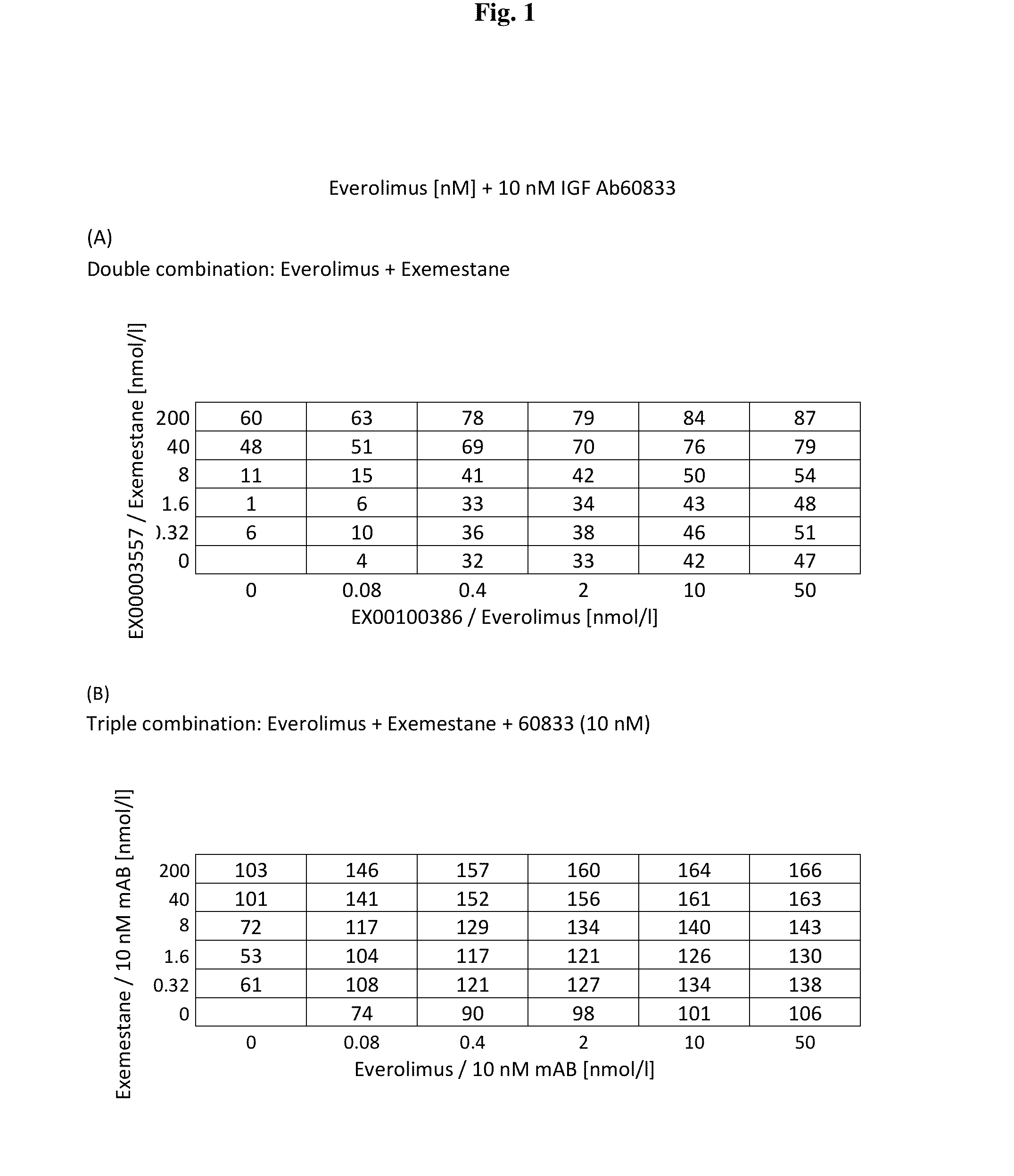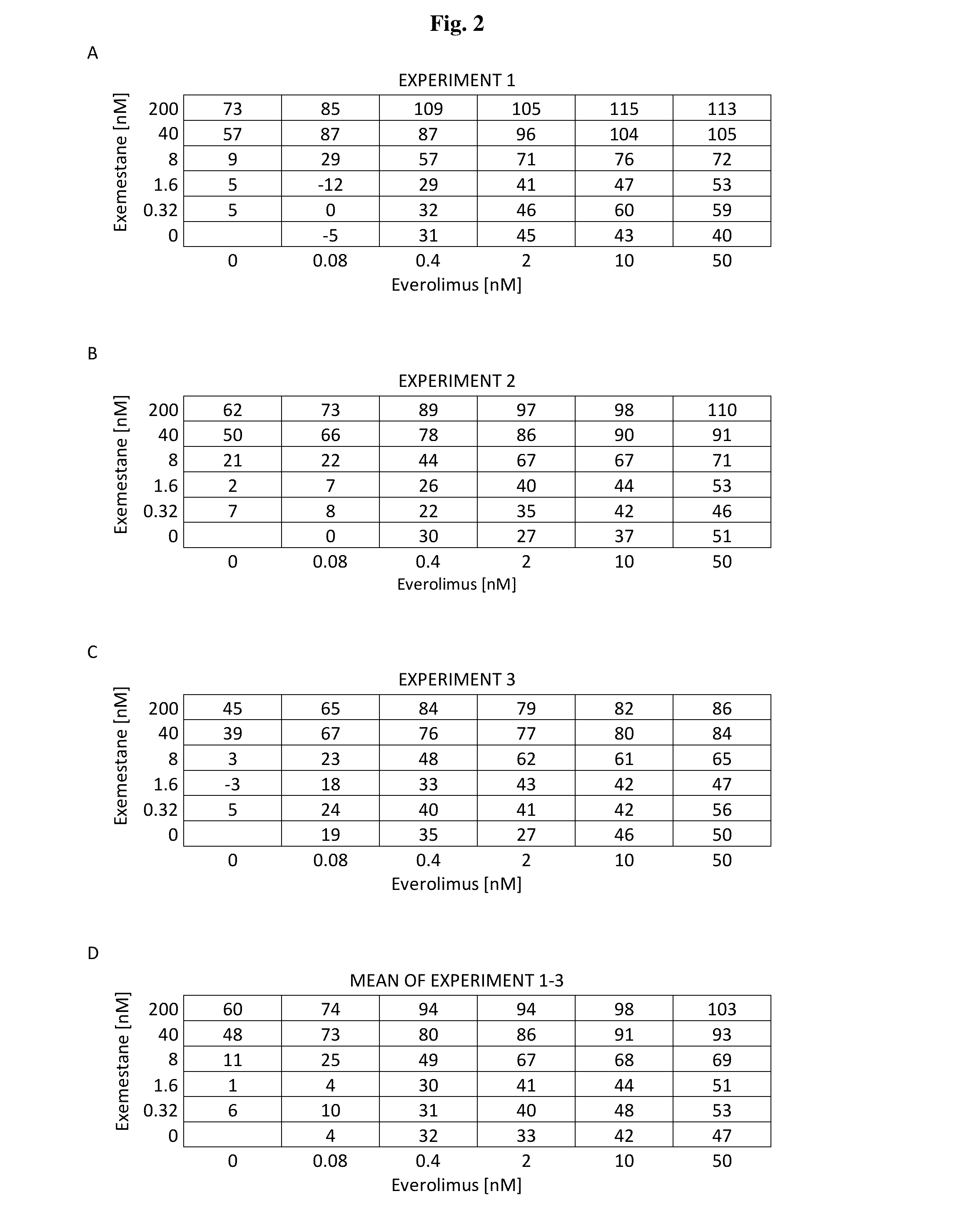Treatment of cancer
a cancer and treatment technology, applied in the field of cancer treatment, can solve the problems of patients who have a response, and patients who have a response, and achieve the effect of reducing the risk of recurren
- Summary
- Abstract
- Description
- Claims
- Application Information
AI Technical Summary
Benefits of technology
Problems solved by technology
Method used
Image
Examples
example 1
Study of IGF Ab 60833 in Combination with Exemestane and Everolimus Versus Exemestane and Everolimus Alone in Women with Locally Advanced or Metastatic Breast Cancer
Introduction
[0099]The study proposed here investigates the effect of IGF Ab 60833 in combination with Exemestane and Everolimus in in estrogen receptor positive metastatic breast cancer.
[0100]In more detail, the phase I part will determine the Maximum Tolerated Dose (MTD) and Recommended Phase II Dose (RP2D) of IGF Ab 60833 and everolimus in combination with exemestane in women with HR+ / HER2− advanced breast cancer. The Phase II part will evaluate the antitumor activity of IGF Ab 60833 in combination with exemestane and everolimus compared to exemestane and everolimus alone in women with HR+ / HER2− advanced breast cancer.
Background
[0101]IGF Ab 60833 is a fully human monoclonal antibody (HumAb) of the IgG1 isotype. The Ab binds with high affinity to IGF-1 and IGF-2, and potently neutralizes the proliferative and prosurviva...
example 2
Preliminary study of IGF Ab 60833 in Combination with Exemestane and Everolimus Versus Exemestane and Everolimus Alone in Women with Locally Advanced or Metastatic Breast Cancer
[0157]Preliminary investigations were performed in to the effect of a triple combination of IGF Ab 60833, everolimus and exemestane, against a double combination of everolimus and exemestane. The investigation was conducted in ER positive breast cancer cell line engineered to expression the human aromatase gene.
[0158]FIG. 1 shows a comparison of the double combination of everolimus and exemestane (top panel) against the triple combination of IGF Ab 60833, everolimus and exemestane (bottom panel).
[0159]It can be clearly seen from a comparison of the two panels that IGF Ab 60833 causes a surprisingly large increase in cell growth inhibition to the everolimus and exemestane combination.
example 3
Effect of IGF Ab 60833 in Combination with the mTOR Inhibitor Everolimus and the Aromatase Inhibitor Exemestane on Growth and Biomarker Phosphorylation Status of the Breast Cancer Cell Line MCF7aro
Summary
[0160]The aim of the present study was to explore the in vitro effect of the combination of IGF Ab 60833, a fully human antibody that binds to IGF-1 and IGF-2, with the mTORC1 inhibitor everolimus and the aromatase inhibitor exemestane on the proliferation of MCF7aro cells, derived from the estrogen receptor positive breast cancer cell line MCF7, engineered to stably express the human aromatase protein.
[0161]MCF7aro breast cancer cells were cultured in steroid-deprived medium, supplemented with the estradiol precursor androstenedione and incubated with IGF Ab 60833, everolimus and exemestane as single agents or in combination, to determine effects on PI3K / mTOR pathway signaling, cell proliferation and survival.
[0162]Whereas treatment of MCF7aro cells with everolimus alone resulted i...
PUM
| Property | Measurement | Unit |
|---|---|---|
| concentration | aaaaa | aaaaa |
| time | aaaaa | aaaaa |
| volume | aaaaa | aaaaa |
Abstract
Description
Claims
Application Information
 Login to View More
Login to View More - R&D
- Intellectual Property
- Life Sciences
- Materials
- Tech Scout
- Unparalleled Data Quality
- Higher Quality Content
- 60% Fewer Hallucinations
Browse by: Latest US Patents, China's latest patents, Technical Efficacy Thesaurus, Application Domain, Technology Topic, Popular Technical Reports.
© 2025 PatSnap. All rights reserved.Legal|Privacy policy|Modern Slavery Act Transparency Statement|Sitemap|About US| Contact US: help@patsnap.com



